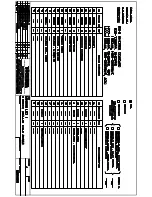
4
With its PowerAssist feature the Multi can add up to 3kVA (that is 3000 / 120 = 25A) to the output during periods of peak power
requirement. Together with a maximum input current of 50A this means that the output can supply up to 50 + 25 = 75A.
An earth leakage circuit breaker and a fuse or circuit breaker rated to support the expected load must be included in
series with the output, and cable cross-section must be sized accordingly.
The maximum rating of the fuse or circuit breaker
is 75A.
•
AC-out-2
(see appendix A)
A second output is available that disconnects its load in the event of battery operation. On these terminals, equipment is connected
that may only operate if AC voltage is available on AC-in
, e.g. an electric boiler or an air conditioner.
The load on AC-out-2 is disconnected immediately when the MultiPlus switches to battery operation. After AC power becomes
available on AC-in, the load on AC-out-2 will be reconnected with a delay of approximately 2 minutes. This to allow a genset to
stabilise.
AC-out-2 can support loads of up to 25A. An earth leakage circuit breaker and fuse rated at max. 32A must be connected in series
with AC-out-2.
Note:
Loads connected to AC-out-2 will be taken into account in the PowerControl / PowerAssist current limit setting. Loads directly
connected to the AC supply will
not
be included in the PowerControl / PowerAssist current limit setting.
2.4 Optional Connections
A number of optional connections are possible:
2.4.1 Second Battery
The MultiPlus has a connection for charging a starter battery. For connection see Appendix A.
2.4.2 Voltage Sense
For compensating possible cable losses during charging, two sense wires can be connected with which the voltage directly on the
battery or on the positive and negative distribution points can be measured. Use wire with a cross-section of 0,75mm².
During battery charging, the MultiPlus will compensate the voltage drop over the DC cables up to a maximum of 1 Volt (i.e. 1V over the
positive connection and 1V over the negative connection). If the voltage drop threatens to become larger than 1V, the charging current
is limited in such a way that the voltage drop remains limited to 1V.
2.4.3 Temperature Sensor
The temperature sensor supplied with the product may be used for temperature-compensated charging (see Appendix A). The sensor is
isolated and must be mounted on the batteries minus pole.
2.4.4 Remote Control
The product can be remotely controlled in two ways.
•
With an external switch (connection terminal L, see appendix A). Operates only if the switch on the MultiPlus is set to “on”.
•
With a Multi Control panel (connected to one of the two RJ48 sockets B, see appendix A). Operates only if the switch on the
MultiPlus is set to “on”.
Only one remote control can be connected, i.e. either a switch or a Multi control panel.
2.4.5. Programmable relays
The relays can be programmed for all kinds of applications, for example as a starter relay for a generating set.
2.4.6 Programmable analog/digital input/output ports
These ports can be used for several purposes. One application is communication with the BMS of a lithium-ion battery.
2.4.7 Auxiliary AC output (AC-out-2)
Besides the usual uninterruptable output, a second output (AC-out-2) is available that disconnects its load in the event of battery
operation. Example: an electric boiler or air conditioner that is allowed to operate only if the genset is running or shore power is
available.
In case of battery operation, AC-out-2 is switched off immediately. After the AC supply has become available, AC-out-2 is reconnected
with a delay of 2 minutes, this to allow a genset to stabilise prior to connecting a heavy load.
2.4.8 Parallel Connection
The MultiPlus can be connected in parallel with several identical devices. To this end, a connection is established between the devices
by means of standard RJ45 UTP cables. The
system
(one or more Multis plus optional control panel) will require subsequent
configuration (see Section 5).
In the event of connecting MultiPlus units in parallel, the following requirements must be met:
•
A maximum of six units connected in parallel.
•
Only identical devices may be connected in parallel.
•
The DC connection cables to the devices must be of equal length and cross-section.
•
If a positive and a negative DC distribution point is used, the cross-section of the connection between the batteries and the DC distribution point must
at least equal the sum of the required cross-sections of the connections between the distribution point and the MultiPlus units.
•
Place the MultiPlus units close to each other, but allow at least 10cm for ventilation purposes under, above and beside the units.
•
UTP cables must be connected directly from one unit to the other (and to the remote panel). Connection/splitter boxes are not permitted.
•
A battery-temperature sensor need only be connected to one unit in the system. If the temperature of several batteries is to be measured, you can
also connect the sensors of other MultiPlus units in the system (with a maximum of one sensor per MultiPlus). Temperature compensation during
battery charging responds to the sensor indicating the highest temperature.
•
Voltage sensing must be connected to the master (see Section 5.5.1.4).
•
Only one remote control means (panel or switch) can be connected to the
system
.
Summary of Contents for MultiPlus Series
Page 2: ......
Page 30: ......
Page 31: ...EN ES Appendix APPENDIX A Overview connections APÉNDICE A Conexiones generales ...
Page 38: ...APPENDIX G Dimensions APÉNDICE G Dimensiones ...
Page 39: ...EN ES Appendix ...
Page 40: ......
Page 41: ......






































